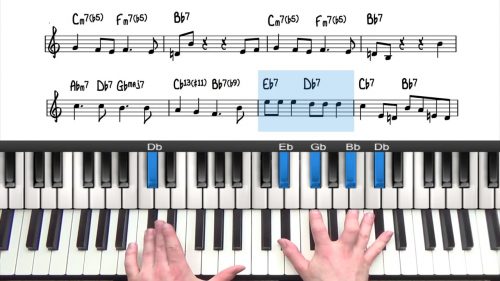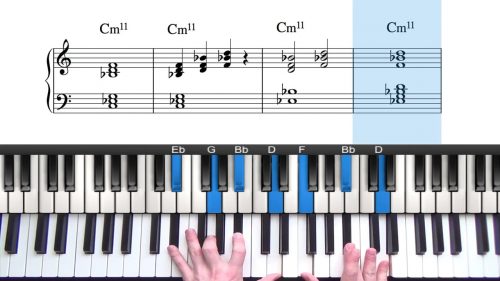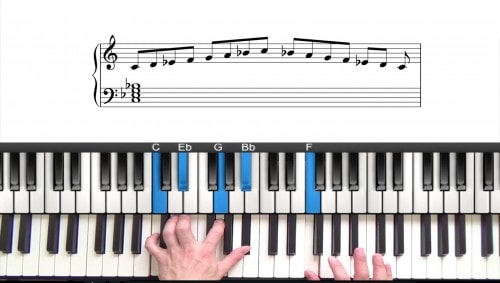Round Midnight Tutorial
Round Midnight is Thelonious Monk’s most famous composition. Written in the key of Eb Minor, the 6 flats in the key signature take some getting used to but the tune contains lots of interesting chord changes and harmonic movements.
Round Midnight is actually the most widely recorded jazz standard written by a jazz musician.
In this tutorial, we explore lots of minor harmony so you should be confident with minor 251s and there variations.
We also introduce some interesting suspended chord movement over the dominant chord at the end of the bridge. The sus13 voicing is a great choice of voicing over dominant chords with the root in the melody.
Find the relavent lessons on minor chords and sus chords in the recommended lesson section below.
Practice Tips
Take a listen to the following recordings of this tune:
-
Thelonious Monk - Round Midnight
-
Bill Evans - Round Midnight (Many Versions)
-
Miles Davis Quintet - Round Midnight
-
Michel Petrucciani - Round Midnight
You should be listening to jazz as much as possible. Make note of anything you like in mm:ss format and then revisit it in your practice time to transcribe the notes and rhythms.
Check out the course on Transcription for more information on this area.







This is a great tutorial. I am surprised it hasn’t got much attention. Anyhow, this will be my first attempt at learning a song without writing anything down. I am hoping to internalize the entire tune. Thanks Hayden for a quality look into Monk.
Hi Adam 👋
Awesome, I’m glad you like the arrangement.
The key signature does make the tune a little tricky but it’s a wonderful tune for practicing minor harmony.
You might also like Tuomo’s lesson on Monk which explores his unique style of playing:
pianogroove.com/jazz-piano-lessons/how-to-play-like-thelonious-monk/
Check that one out too.
Cheers,
Hayden
Hi Hayden,
One of my favorite all times tune, however I believe this tune is more challenging from the ones I already completed tutorial in Piano groove (Tendely, Days wine roses, misty, Naima, etc…).
I strugle with playing the melody in time.
@Hayden – Might you have some tips for me with playing the melody of this tune in time?
I think I play the 16 notes faster, then it corrupts my entire time with the quarter notes as well :)
Thanks.
Ariel
Hi Ariel 👋
Yes this is a tricky tune to play. It’s certainly more difficult than the other tunes you mention. The key signature makes it challenging in addition to the syncopated melody and fast chord changes.
For playing the melody in time, my biggest recommendation would be to play along with your favourite recording of the tune and try to emulate the exact phrasing.
Playing along with a metronome can also be helpful but I’d first start by playing along with some notable recordings.
Hope that helps and any other questions let me know.
Cheers,
Hayden
I’ve worked on this for several hours every day for the past five days, and I can now play it through in the first, simple arrangement almost without mistakes. This is an order of magnitude above my playing level when I joined pianogroove a bit over a year ago. Very, very happy with that. I’m also at least trying to analyze the harmonies in this song, and right away I can see that the words “diatonic” and “Thelonius” are not synonyms. Improv over this piece will require a whole lot of work.
Hi
I see some songs have mp3 files. Is there one for Round Midnight? Is there something I can do with midi file?
Thanks
Gregg
Hi Greg,
Sorry for the late reply here.
Currently an audio file does not exist for this lesson – but I will create one and upload to the lesson page Downloads section.
The Midi file for this lesson was generated by one of our students. He created these files for some of our lessons using his music notation software. Midi files can be read by different software/programs such as Logic, Midiculous, and many other programs.
The main benefit of Midi files is that they contain all of the note information of a performance which can then be interpreted by different software. This can be in a visual way – such as the light-up keyboard that you see in all of our tutorials on PianoGroove – or it can be used to generate an audio file.
For example if I record a performance in Midi, I can then export it as audio using any piano sound and the result will be an audio file that does not have any interference caused by background noise and also no need to invest in high tech recording equipment to capture the audio in the first place. The Midi is simply captured by a cable running from an electric piano/keyboard to a laptop or computer.
Midi can also be used to change the sound. For example, if we record in Midi, we can then turn that into an audio file using any piano sound, or any ‘virtual software instrument’ using programs such as Logic, Ableton, GarageBand etc…. So you could take a piano performance recorded in midi, and in the click of a button switch the sound from piano, to Rhodes, to organ, to guitar, or to any instrument you can think of. This is commonly used by music producers etc…
Finally, we can use a midi file to transpose a line, lick, or phrase into a different key using software such as Midiculous – although as jazz musicians we should do transposition without the help of software!
So yes there are many ways that we can use Midi – whether these will be of interest to you I’m unsure but these are the main uses.
I hope that helps and talk soon,
Hayden